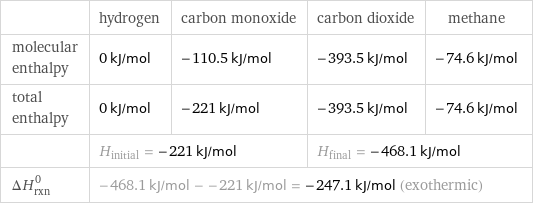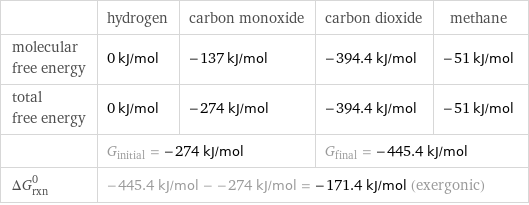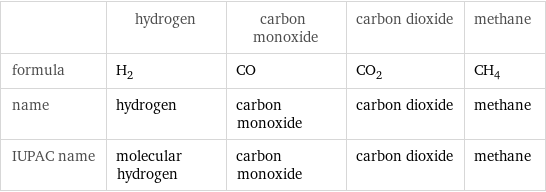Input interpretation

H_2 hydrogen + CO carbon monoxide ⟶ CO_2 carbon dioxide + CH_4 methane
Balanced equation

Balance the chemical equation algebraically: H_2 + CO ⟶ CO_2 + CH_4 Add stoichiometric coefficients, c_i, to the reactants and products: c_1 H_2 + c_2 CO ⟶ c_3 CO_2 + c_4 CH_4 Set the number of atoms in the reactants equal to the number of atoms in the products for H, C and O: H: | 2 c_1 = 4 c_4 C: | c_2 = c_3 + c_4 O: | c_2 = 2 c_3 Since the coefficients are relative quantities and underdetermined, choose a coefficient to set arbitrarily. To keep the coefficients small, the arbitrary value is ordinarily one. For instance, set c_3 = 1 and solve the system of equations for the remaining coefficients: c_1 = 2 c_2 = 2 c_3 = 1 c_4 = 1 Substitute the coefficients into the chemical reaction to obtain the balanced equation: Answer: | | 2 H_2 + 2 CO ⟶ CO_2 + CH_4
Structures

+ ⟶ +
Names

hydrogen + carbon monoxide ⟶ carbon dioxide + methane
Reaction thermodynamics
Enthalpy

| hydrogen | carbon monoxide | carbon dioxide | methane molecular enthalpy | 0 kJ/mol | -110.5 kJ/mol | -393.5 kJ/mol | -74.6 kJ/mol total enthalpy | 0 kJ/mol | -221 kJ/mol | -393.5 kJ/mol | -74.6 kJ/mol | H_initial = -221 kJ/mol | | H_final = -468.1 kJ/mol | ΔH_rxn^0 | -468.1 kJ/mol - -221 kJ/mol = -247.1 kJ/mol (exothermic) | | |
Gibbs free energy

| hydrogen | carbon monoxide | carbon dioxide | methane molecular free energy | 0 kJ/mol | -137 kJ/mol | -394.4 kJ/mol | -51 kJ/mol total free energy | 0 kJ/mol | -274 kJ/mol | -394.4 kJ/mol | -51 kJ/mol | G_initial = -274 kJ/mol | | G_final = -445.4 kJ/mol | ΔG_rxn^0 | -445.4 kJ/mol - -274 kJ/mol = -171.4 kJ/mol (exergonic) | | |
Entropy

| hydrogen | carbon monoxide | carbon dioxide | methane molecular entropy | 115 J/(mol K) | 198 J/(mol K) | 214 J/(mol K) | 186 J/(mol K) total entropy | 230 J/(mol K) | 396 J/(mol K) | 214 J/(mol K) | 186 J/(mol K) | S_initial = 626 J/(mol K) | | S_final = 400 J/(mol K) | ΔS_rxn^0 | 400 J/(mol K) - 626 J/(mol K) = -226 J/(mol K) (exoentropic) | | |
Equilibrium constant
![Construct the equilibrium constant, K, expression for: H_2 + CO ⟶ CO_2 + CH_4 Plan: • Balance the chemical equation. • Determine the stoichiometric numbers. • Assemble the activity expression for each chemical species. • Use the activity expressions to build the equilibrium constant expression. Write the balanced chemical equation: 2 H_2 + 2 CO ⟶ CO_2 + CH_4 Assign stoichiometric numbers, ν_i, using the stoichiometric coefficients, c_i, from the balanced chemical equation in the following manner: ν_i = -c_i for reactants and ν_i = c_i for products: chemical species | c_i | ν_i H_2 | 2 | -2 CO | 2 | -2 CO_2 | 1 | 1 CH_4 | 1 | 1 Assemble the activity expressions accounting for the state of matter and ν_i: chemical species | c_i | ν_i | activity expression H_2 | 2 | -2 | ([H2])^(-2) CO | 2 | -2 | ([CO])^(-2) CO_2 | 1 | 1 | [CO2] CH_4 | 1 | 1 | [CH4] The equilibrium constant symbol in the concentration basis is: K_c Mulitply the activity expressions to arrive at the K_c expression: Answer: | | K_c = ([H2])^(-2) ([CO])^(-2) [CO2] [CH4] = ([CO2] [CH4])/(([H2])^2 ([CO])^2)](../image_source/c2f94525606f00f26043c672be33e18d.png)
Construct the equilibrium constant, K, expression for: H_2 + CO ⟶ CO_2 + CH_4 Plan: • Balance the chemical equation. • Determine the stoichiometric numbers. • Assemble the activity expression for each chemical species. • Use the activity expressions to build the equilibrium constant expression. Write the balanced chemical equation: 2 H_2 + 2 CO ⟶ CO_2 + CH_4 Assign stoichiometric numbers, ν_i, using the stoichiometric coefficients, c_i, from the balanced chemical equation in the following manner: ν_i = -c_i for reactants and ν_i = c_i for products: chemical species | c_i | ν_i H_2 | 2 | -2 CO | 2 | -2 CO_2 | 1 | 1 CH_4 | 1 | 1 Assemble the activity expressions accounting for the state of matter and ν_i: chemical species | c_i | ν_i | activity expression H_2 | 2 | -2 | ([H2])^(-2) CO | 2 | -2 | ([CO])^(-2) CO_2 | 1 | 1 | [CO2] CH_4 | 1 | 1 | [CH4] The equilibrium constant symbol in the concentration basis is: K_c Mulitply the activity expressions to arrive at the K_c expression: Answer: | | K_c = ([H2])^(-2) ([CO])^(-2) [CO2] [CH4] = ([CO2] [CH4])/(([H2])^2 ([CO])^2)
Rate of reaction
![Construct the rate of reaction expression for: H_2 + CO ⟶ CO_2 + CH_4 Plan: • Balance the chemical equation. • Determine the stoichiometric numbers. • Assemble the rate term for each chemical species. • Write the rate of reaction expression. Write the balanced chemical equation: 2 H_2 + 2 CO ⟶ CO_2 + CH_4 Assign stoichiometric numbers, ν_i, using the stoichiometric coefficients, c_i, from the balanced chemical equation in the following manner: ν_i = -c_i for reactants and ν_i = c_i for products: chemical species | c_i | ν_i H_2 | 2 | -2 CO | 2 | -2 CO_2 | 1 | 1 CH_4 | 1 | 1 The rate term for each chemical species, B_i, is 1/ν_i(Δ[B_i])/(Δt) where [B_i] is the amount concentration and t is time: chemical species | c_i | ν_i | rate term H_2 | 2 | -2 | -1/2 (Δ[H2])/(Δt) CO | 2 | -2 | -1/2 (Δ[CO])/(Δt) CO_2 | 1 | 1 | (Δ[CO2])/(Δt) CH_4 | 1 | 1 | (Δ[CH4])/(Δt) (for infinitesimal rate of change, replace Δ with d) Set the rate terms equal to each other to arrive at the rate expression: Answer: | | rate = -1/2 (Δ[H2])/(Δt) = -1/2 (Δ[CO])/(Δt) = (Δ[CO2])/(Δt) = (Δ[CH4])/(Δt) (assuming constant volume and no accumulation of intermediates or side products)](../image_source/3666881847de0dea0c7cc4b86f7acf09.png)
Construct the rate of reaction expression for: H_2 + CO ⟶ CO_2 + CH_4 Plan: • Balance the chemical equation. • Determine the stoichiometric numbers. • Assemble the rate term for each chemical species. • Write the rate of reaction expression. Write the balanced chemical equation: 2 H_2 + 2 CO ⟶ CO_2 + CH_4 Assign stoichiometric numbers, ν_i, using the stoichiometric coefficients, c_i, from the balanced chemical equation in the following manner: ν_i = -c_i for reactants and ν_i = c_i for products: chemical species | c_i | ν_i H_2 | 2 | -2 CO | 2 | -2 CO_2 | 1 | 1 CH_4 | 1 | 1 The rate term for each chemical species, B_i, is 1/ν_i(Δ[B_i])/(Δt) where [B_i] is the amount concentration and t is time: chemical species | c_i | ν_i | rate term H_2 | 2 | -2 | -1/2 (Δ[H2])/(Δt) CO | 2 | -2 | -1/2 (Δ[CO])/(Δt) CO_2 | 1 | 1 | (Δ[CO2])/(Δt) CH_4 | 1 | 1 | (Δ[CH4])/(Δt) (for infinitesimal rate of change, replace Δ with d) Set the rate terms equal to each other to arrive at the rate expression: Answer: | | rate = -1/2 (Δ[H2])/(Δt) = -1/2 (Δ[CO])/(Δt) = (Δ[CO2])/(Δt) = (Δ[CH4])/(Δt) (assuming constant volume and no accumulation of intermediates or side products)
Chemical names and formulas

| hydrogen | carbon monoxide | carbon dioxide | methane formula | H_2 | CO | CO_2 | CH_4 name | hydrogen | carbon monoxide | carbon dioxide | methane IUPAC name | molecular hydrogen | carbon monoxide | carbon dioxide | methane